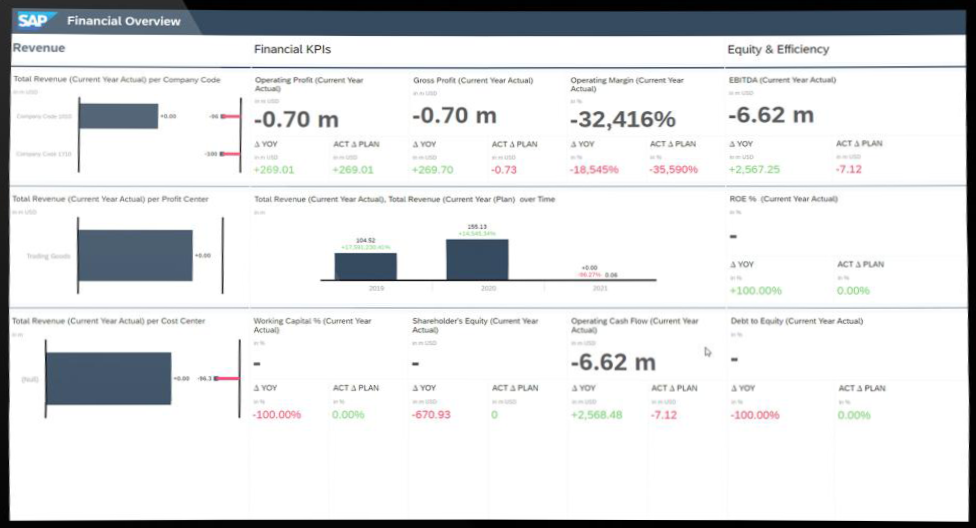SAP DATAWAREHOUSE CLOUD (DWC)
SAP Data Warehouse Cloud completes SAP's portfolio with a solution optimized for both SAP HANA in-memory databases and the SAP Cloud environment (SAP Business Technology Platform). It is exactly what its name promises: a variably usable and flexibly scalable "software as a service" model ("cloud") for combining data from multiple - usually heterogeneous - sources and optimizing it for analysis purposes ("data warehouse").
In contrast to the on-premise technology BW/4HANA, the Data Warehouse Cloud does not include an application platform for in-house developments or individual applications.
Rather, the Data Warehouse Cloud relies on SQL technology to map the business logic in order to exploit the full potential of a
in-memory database ("code to data" paradigm).
However, if you want applications that go beyond business logic and provide entire user interfaces, this can be achieved in combination with the SAP Business Technology Platform.
Increased agility through flexible scalability
The deployment scenario of an SAP DWC is pure data warehousing with cloud technology. Compared to on-premise technology, the greatest added value of a cloud-based solution via Software as a Service lies in its flexibility. Available users, storage space, or even entire subareas ("Spaces") can be scaled quickly and at will, depending on requirements.
For example, if additional requirements are added to the DWC, they can be implemented directly, while unused resources can be quickly terminated to avoid unnecessary costs.
Both of these factors mean that projects can be carried out flexibly and quickly, if necessary. can also be initiated and implemented directly by the department. Since only minor costs are incurred, the usual consideration of investment protection when purchasing software is irrelevant.
Simple modeling in the business layer
In addition to the technological advantages of the data warehouse cloud, there are also practical advantages that can be used directly. For example, the user interface included as standard enables the department to load and manage data itself. In the "Business Layer", this data can be modeled and enriched with business logic.
This also enables a faster response to new requirements and thus strengthens agility and innovation in the company.
Integration of local, non-harmonized data
This approach also offers the opportunity to integrate data that previously existed completely apart from any business data governance in local Excel files or other non-orchestrated sources.
The SAP Data Warehouse Cloud now offers around 30 adapters for data sources (
SAP Help Portal - DWC Connection Types
). Depending on the connection type, replication, or even a virtual connection of data sources is possible with it.
Users also do not have to rely solely on SAP Analytics Cloud as a BI client to consume the data after applying the business logic. Rather, Tableau, Excel and Power BI can also consume the data from the Data Warehouse Cloud directly. By means of an ODBC driver, this series can also be extended to any other third-party bi-clients.

Use the full bandwidth of an SQL data warehouse
If a prototype developed with the data warehouse cloud now reaches a level of maturity in terms of useful life and, above all, complexity, it may be desirable to hand over the project to IT.
This can draw on the full bandwidth of an SQL data warehouse . The range of tools in the data layer then goes from graphical views to SQL views. Grapical Views provide a clear and accessible graphical editor to easily create and manage SQL statements.
Much higher functionality is provided by SQL views, which allow both simple SQL statements and complex use of SQL scripts (Table Function). A more specific use case, namely the operation of an SQL data warehouse (for example in a hybrid use of BW/4HANA and HANA native), is also covered by this.
Conclusion
The SAP Data Warehouse Cloud should not be understood as BW/4HANA in the cloud. Rather, we see a flexible deployment scenario as realistic. In this case, the data warehouse cloud enables rapid prototyping by involving business users more closely and reducing the involvement of IT. As a result, much previously unharmonized data can be integrated into business data governance. Many connection types and high compatibility with bi-tools contribute to usability and acceptance. Last but not least, SQL data warehousing also enables the mapping of complex logics.
Our offer
If you are interested in the Data Warehouse Cloud and require further information or assistance regarding the use of the Data Warehouse Cloud, we will be happy to support you with professional and technical expertise.
A first step could be a workshop in which we jointly develop the key points of the target scenario. Please feel free to contact us without obligation.
